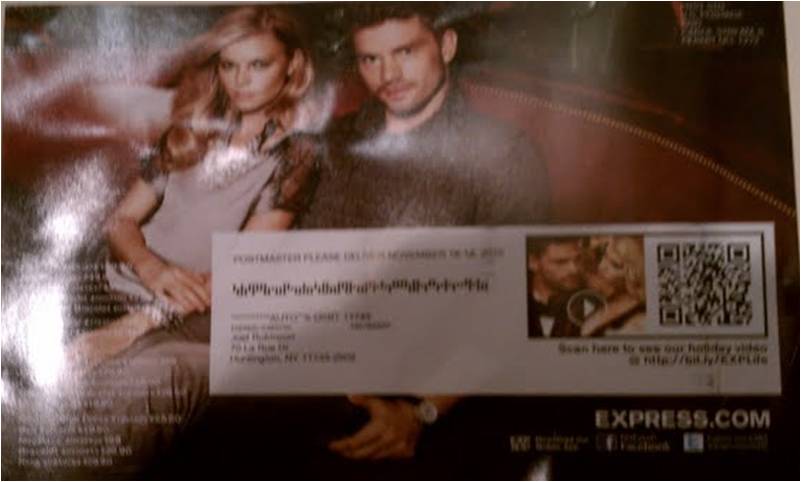You’ve heard the derogatory term “snail mail” which connotes that postal mail is out of touch with digital life. Like the dinosaur but worse, because we do not even get fossil fuel out of it!
Well, not so fast!
On Saturday, my mailer from Express WAS digital! It was a really slick mailed brochure with coupons that would take me through the holiday shopping season but there was more. It had a QR code (2 dimensional bar code) on the back. Bar code scanner apps on any smart phone can read this type of code. Mine (a Droid Incredible) instantly recognized the code and took me to an edgy video on an Express web page. From there I could download a smartphone app, get to their Facebook page and follow them on Twitter. Sight, sound, motion, social media, mobile all in one mailer that came via the post office; not bad for good old snail mail, eh? 
I remember Greg Whiteman, the head of research for the USPS telling me that there is a great advertising selling story for the post office based on engagement. You touch every piece of mail, even if you are going to get rid of it. Imagine if every TV or display impression was seen? They would give their eye teeth for that type of attentiveness.
So now you have attentiveness and digitalization all in one ad impression as the USPS becomes a digital medium.
Marketing analysts also have powerful measurement possibilities. Here are eight things that are possible (I don’t work with Express so I don’t know if they actually do this).
- Measure the “click through” and conversion rates; how many actually image the QR code and then engage in various actions like watching the video, going to Facebook, Twitter, actually making a purchase online, etc.
- Measure the interaction by day and hour
- Capture the smart phone operating system
- Calculate conversion measured in different ways
- Since people can get to the landing page different ways, calculate the share of referring traffic for the mailer vs. organic traffic or search.
- The ability to create an experimental design so you can systematically manipulate creative elements, learn what works best in-flight and optimize in real time.
- Embed unique identifiers so you can track the sharing patterns of content on the landing page where traffic came via the QR code vs. other sources.
- At some point, when mobile payment comes to the US, we can integrate print ads, digital payment, and presumably shipping information.
The use of QR codes not only allows the advertiser to offer the tactile engagement of print and benefits of digital all at the same time, but it is not too late to gain marketing advantage vs. competitors. On the same day that I received the Express mailer, I got a few catalogues in the mail; not a QR code to be seen. OK, then Sunday, I checked the business section of the NY Times. Guess what? No QR codes, nada for a readership that must have a really high index of owning smart phones! QR codes could make the content digitally sharable, create real time readership metrics, and turn advertising within the print edition into something digital without having to buy a Kindle or iPad (can’t fold those in that famous commuter way, proving you’re a pro!)
Oh, BTW, the creation of QR codes is basically free, so what’s the holdup? In my last blog, I talked about resistance to change in the form of embracing new technology while still holding onto old practices that are incongruous to protect ourselves psychologically against disruptive change. Earlier, I blogged about digitalization of all media. Come on my marketing and measurement colleagues, it’s a new digital age!


Joel’s thinking always takes me to the edge. This piece really stretches my thinking about new and creative ways to market (and research) our product offerings. I’d say “brilliant,” but that would be an understatement.